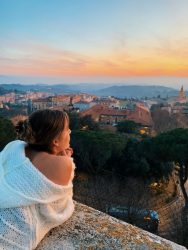By Jacqueline Inman, University of Vermont
Perugia is home to many amazing sights for visitors to see: the Etruscan Well, the National Gallery of Umbria, stores, and restaurants in the central piazzas, and panoramic views from Porta Sole. But, when you’re staying in Perugia for an extended visit, like the students at the Umbra Institute, there is room to make your Perugian experience your own, finding the best spots off the beaten path. After having spent just over two months in Perugia, these are the places I would recommend visiting if you are interested in the creative sides of Perugia.
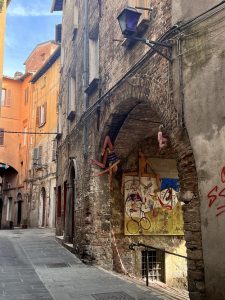
Via della Viola
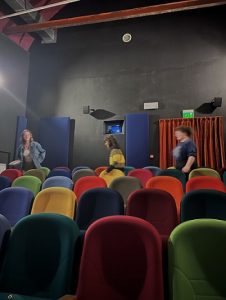
Via della Viola is a street not far from the central Piazza Novembre IV, offering an artistic side of Perugia. Funky and colorful murals line the street, along with some of the coziest bars and restaurants, such as Civico 25 and La Fame. The street is home to Perugia’s movie theater, Postmodernismo, which screens many independent films. The stylish theater doubles as a bar and hosts community arts events. Every Wednesday, they show movies in English, creating a great mid-week activity for English-speaking students. Postmodernismo is a vastly different environment from a chain AMC theater that you would find in the U.S., providing the viewer with a classy movie-watching experience. It may not sell slushies and heaping bags of popcorn, but you can get a cocktail or glass of wine to go along with your movie.
Corso Cavour
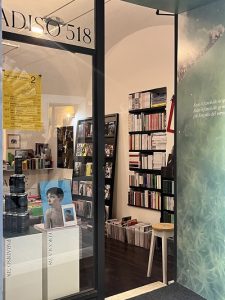
Corso Cavour is another Perugian street that took me a few weeks to happen upon. If you walk down the long stairway of Sant’Ercolano, you will end up on Corso Cavour, immediately greeted by some of the spots that I would recommend spending time in.
Paradiso 518 arts bookshop, Caffè Della Penna, and Lick Gelato are clustered near each other on Corso Cavour. Paradiso 518 is not the average bookstore but describes itself as an art bookshop and micro-gallery. It is an intriguing place to browse around, full of creative books and magazines set up to make the store an aesthetic experience. Right across from Paradiso 518 is Caffè Della Penna, a particularly cozy cafe and my favorite place to study. Della Penna has a sitting room in the back of the café with a warm ambiance like no other café I have been to in Perugia. Finally, Lick Gelato, next to Paradiso 518, is well-known in Perugia for some of the best gelato around. Lick is an artisan-style gelato and cake shop, and is a must if you enjoy fun and unique gelato flavors.
Pian di Massiano Saturday Market
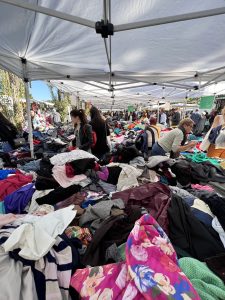
If you’re interested in shopping for cheap, second-hand, or vintage clothing, the Pian di Massiano Market that occurs every Saturday is the place to go. From the Pincetto mini metro stop that is located right near the historic center of Perugia, it is a 15-minute ride down the hill to the last stop of the mini metro called Pian di Massiano.
There are a wide variety of goods sold at the market, including sandwiches, fruit, jewelry, home goods, and my favorite part – vintage clothing. Clothing stands make up most of the market, offering tables piled high with second-hand, generally high-quality items for people to sift and dig through. The clothes mostly range in price from 1 to 5 euros. The market opens at 8 am and goes until 1 pm on Saturdays, so there is plenty of time to search through the never-ending heaps of clothing.
Piazza San Francesco
Finally, when it’s a beautiful day and you’re tired from walking around the hilly town of Perugia, you can find a grassy area to lay down on a blanket in front of the beautiful Church of San Francesco al Prato. This is my favorite place to go with friends to read a book, listen to music, or just soak up the sun if it’s out. An added plus of this area is that there is functional wifi that you can connect to, making homework or studying possible from outside.
There are many more wonderful places to see in Perugia, and I am constantly discovering new ones. But, if you are looking for creative and cozy places to visit in Perugia that might not be found in your first google search, these suggestions are worth the visit.


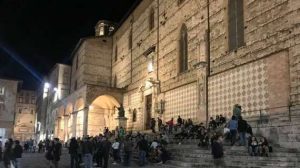 bar, an American-owned bar which always has a huge ground outside, but even though it’s an American bar, there is no shortage of Italians outside. Or maybe you’ll decide to walk around the corner to Marla’s, a two-floored bar which normally hosts live music. There are also plenty of great areas away from the main piazza and great spots to practice your Italian the further you go from the piazza as they are where the locals tend to hang out. Streets like Corso Cavour and Via della Viola are great areas to interact with the locals. Via della Viola, with fun places like C’era una Vodka or Agricola, is very interesting as you can hear street musicians playing well into the late hours of the night. But watch out as you may have to squeeze to the sides of the street every once in a while as an unfortunate driver tries to navigate through the crowds of people! If you’re into dancing, maybe you’ll visit one of the few discotecas right outside the city, although I personally haven’t visited them as nobody wants to see my dance moves. Or better yet, you may even run into some of the Umbra Institute staff at Elfo’s Pub right off of Via dei Priori collectively enjoying a soccer match on the large projector there. There is no shortage of great venues and spots for all here in Perugia.
bar, an American-owned bar which always has a huge ground outside, but even though it’s an American bar, there is no shortage of Italians outside. Or maybe you’ll decide to walk around the corner to Marla’s, a two-floored bar which normally hosts live music. There are also plenty of great areas away from the main piazza and great spots to practice your Italian the further you go from the piazza as they are where the locals tend to hang out. Streets like Corso Cavour and Via della Viola are great areas to interact with the locals. Via della Viola, with fun places like C’era una Vodka or Agricola, is very interesting as you can hear street musicians playing well into the late hours of the night. But watch out as you may have to squeeze to the sides of the street every once in a while as an unfortunate driver tries to navigate through the crowds of people! If you’re into dancing, maybe you’ll visit one of the few discotecas right outside the city, although I personally haven’t visited them as nobody wants to see my dance moves. Or better yet, you may even run into some of the Umbra Institute staff at Elfo’s Pub right off of Via dei Priori collectively enjoying a soccer match on the large projector there. There is no shortage of great venues and spots for all here in Perugia.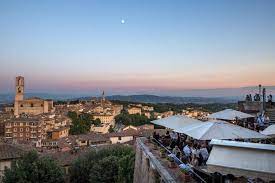 Despite all these great places I’ve mentioned, they’ve not been the most memorable part of the nightlife for me here in Perugia. The most memorable for me by far, has been the people. What makes Perugia fundamentally different from a larger city, is the fact that you really feel like a part of the city and community. I have had the wonderful opportunity to meet people from around the world here, not just from Italy but from countries far and wide like Canada, Spain, France, Russia, South Africa, Germany and more. Perugia feels like a melting pot where everyone is open to meeting new people. In larger cities, people are often wary of those they don’t know and will only stick to their friend group. Here in Perugia I’ve found myself engaging in conversations with people from different countries and cultures, with widely different ages and backgrounds. The people here are excited to meet new people and hear their stories.
Despite all these great places I’ve mentioned, they’ve not been the most memorable part of the nightlife for me here in Perugia. The most memorable for me by far, has been the people. What makes Perugia fundamentally different from a larger city, is the fact that you really feel like a part of the city and community. I have had the wonderful opportunity to meet people from around the world here, not just from Italy but from countries far and wide like Canada, Spain, France, Russia, South Africa, Germany and more. Perugia feels like a melting pot where everyone is open to meeting new people. In larger cities, people are often wary of those they don’t know and will only stick to their friend group. Here in Perugia I’ve found myself engaging in conversations with people from different countries and cultures, with widely different ages and backgrounds. The people here are excited to meet new people and hear their stories. 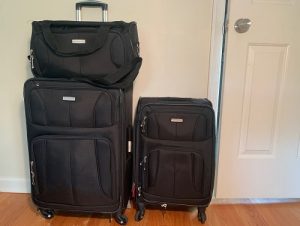 When packing for your study abroad experience, there are four important items that you should make sure you have packed.
When packing for your study abroad experience, there are four important items that you should make sure you have packed.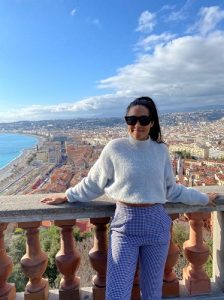 Now it is time to share what most people probably came to this article; to figure out what types of clothing to bring with you for your four-month abroad experience in Italy. Before giving you my recommendations on what types of clothes you should bring, I think it is important to note some important aspects of packing. First off, do not pack outfits. You will be in Italy between 110-120 days unless you decide to stay longer. Your suitcase will not be able to fit 122 different outfits. Therefore, I recommend bringing clothing items that can be interchanged with one another. In addition to this, remember that you are going to Italy, which is one of the biggest fashion capitals in the world. So, don’t be afraid to take a break from your sweatpants and try new clothes that you may have been too scared to wear here in the United States. I encourage you to take advantage of your creativity and to get out of your comfort zone with your fashion pieces!
Now it is time to share what most people probably came to this article; to figure out what types of clothing to bring with you for your four-month abroad experience in Italy. Before giving you my recommendations on what types of clothes you should bring, I think it is important to note some important aspects of packing. First off, do not pack outfits. You will be in Italy between 110-120 days unless you decide to stay longer. Your suitcase will not be able to fit 122 different outfits. Therefore, I recommend bringing clothing items that can be interchanged with one another. In addition to this, remember that you are going to Italy, which is one of the biggest fashion capitals in the world. So, don’t be afraid to take a break from your sweatpants and try new clothes that you may have been too scared to wear here in the United States. I encourage you to take advantage of your creativity and to get out of your comfort zone with your fashion pieces!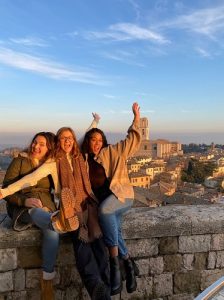 But the most important items are…
But the most important items are…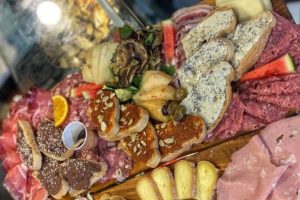 Charcuterie: La Prosciutteria
Charcuterie: La Prosciutteria 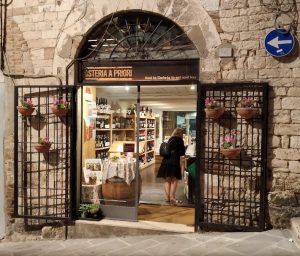 Traditional Osteria: Osteria a Priori
Traditional Osteria: Osteria a Priori 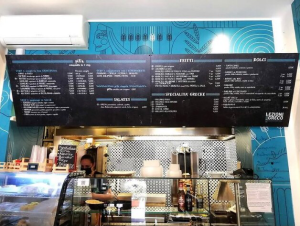 Non-Italian: Lezioni Di Greco Corner
Non-Italian: Lezioni Di Greco Corner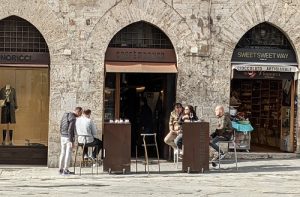 Caffè del Banco
Caffè del Banco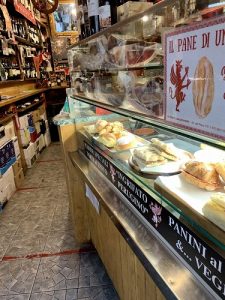 Caffè Dal Perugino
Caffè Dal Perugino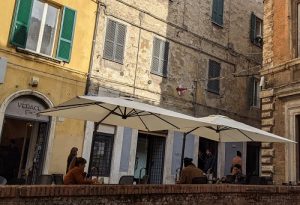 Verace
Verace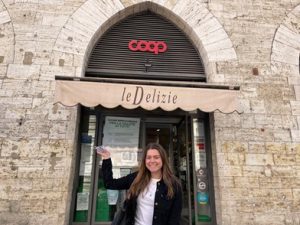 The Coop
The Coop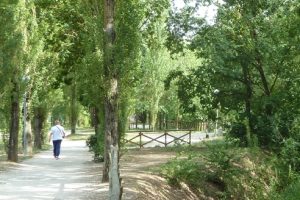
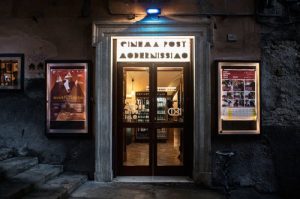
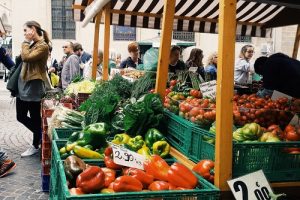
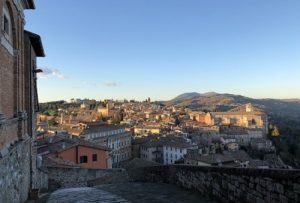
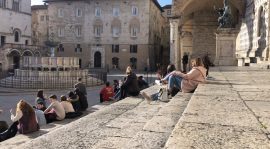 I may not be from you, but you have made me feel more than welcomed, and there’s no other place that makes me feel the way you do. You make me open my windows in the morning and stick my head out to take in the fresh Perugian air. I love your warm cappuccinos in the morning that make me think about all that I’m grateful for in life. It is the simplicity of eating a warm fluffy croissant on the steps of the piazza that makes me smile. Oh, those wonderful steps. They are comforting and always there for me. They speak to me, fulfill me and introduce me to my soon to be friends. On days filled with bright blue skies and a strong sun, I sit there and bask, soaking up the warmth. I observe the pigeons that gather and then flock. I observe the locals, strolling, arm in arm, on their afternoon walk. I overhear their conversations, the Iitalian language is a constant song I love to listen to.
I may not be from you, but you have made me feel more than welcomed, and there’s no other place that makes me feel the way you do. You make me open my windows in the morning and stick my head out to take in the fresh Perugian air. I love your warm cappuccinos in the morning that make me think about all that I’m grateful for in life. It is the simplicity of eating a warm fluffy croissant on the steps of the piazza that makes me smile. Oh, those wonderful steps. They are comforting and always there for me. They speak to me, fulfill me and introduce me to my soon to be friends. On days filled with bright blue skies and a strong sun, I sit there and bask, soaking up the warmth. I observe the pigeons that gather and then flock. I observe the locals, strolling, arm in arm, on their afternoon walk. I overhear their conversations, the Iitalian language is a constant song I love to listen to.